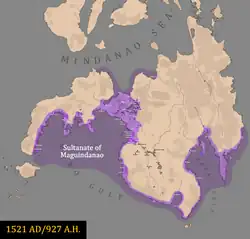| Muhammad Kabungsuwan | |||||
|---|---|---|---|---|---|
| 1st Sultan of Maguindanao | |||||
| Reign | 1515[1][2]–1543 | ||||
| Successor | Sultan Maka-alang Saripada | ||||
| Born | unknown Johore | ||||
| Died | 1543 Maguindanao | ||||
| Burial | |||||
| Spouses | Putri Tunina (Rajah Tabunaway's daughter) Angintabo (Iranun princess) | ||||
| Issue | Sultan Maka-alang Saripada Dayang Daragat Layagun Aloyodan nine other children | ||||
| |||||
| House | House of Maguindanao | ||||
| Mother | Daughter of Sultan Iskandar Zhulkarnain of Malacca | ||||
| Religion | Sunni Islam | ||||
Shariff Muhammed Kabungsuwan[3] (Malay: Muhammad Kebungsuwan, Jawi: شريف کبوڠسووان; Maguindanaon: Muhammad Kabunsuan, Jawi: شريف کبوڠسوان) was the first Sultan of Maguindanao in the Philippines. A native of Johore in Maritime Southeast Asia, Kabungsuwan re-settled in Mindanao in the Philippines where he preached Islam to the native tribes around the region.[4][5]
Origin
Maguindanao genealogy records state that Kabungsuwan's father was an Arab and a sharif or a descendant of the Islamic prophet Mohammed while his mother was Malay. His recorded name "Kabungsuwan" in Maguindanao tradition means "youngest" and is said to the be the youngest among three children. His eldest brother, Ahmad is said to have established the Bruneian Sultanate while his other brother Alawi is said to have set up the Sulu Sultanate.[6]
Mission work in Mindanao

Kabungsuwan is generally regarded as the one who introduced Islam in the Lanao and Maguindanao areas in Mindanao arriving in the area in the early 16th century. There are several tarsilas or written genealogy on Kabungsuwan though most of these state that he brought in men when he landed in Mindanao, his group are composed of seafarers, there was initial force with his group's interaction with the locals and that there were already Muslims in Mindanao when his Kangungsuwan and his men landed near the mouth of the Pulangi River. Kabungsuwan formed alliances with influential royal families of Sulu, Borneo, and Ternate. This led to Islam becoming the dominant religion around Lake Lanao by the 19th century.[7]
Personal life
Kabungsuwan traded in T'buk, old name of Malabang, Lanao.[8]
Kabungsuwan was of Arab-Malay ethnicity. He married a local princess and established the Sultanate of Maguindanao in the 16th century.[4] The sultanate was usually centered in the valley of Cotabato.
Legacy
The former province of Shariff Kabunsuan in the Philippines was named after him.
Notes
- ↑ Kalipa, Candidato L.; Lumapenet, Husna T. (December 2021). ""The Authorities and Customary Practices of the Buayan Sultanates in the Philippines"" (PDF).
- ↑ Bacani, Benedicto R. (January 2005). ""The Mindanao Peace Talks: Another Opportunity to Resolve the Moro Conflict in the Philippines"" (PDF).
- ↑ Ang Bayan Sa Labas Ng Maynila (2008), pg 195
- 1 2 "History/The%20Maguindanao%20Sultanate". mnlf.net. Retrieved August 23, 2015.
- ↑ "WebCite query result". webcitation.org. Archived from the original on October 19, 2009. Retrieved August 23, 2015.
{{cite web}}: Cite uses generic title (help) - ↑ Gonda, John, ed. (1975). "The Muslims of the Philippines". Handbook of Oriental Studies. Section 3 Southeast Asia, Religions, Religionen. BRILL. p. 93. ISBN 9004043306.
- ↑ Nathan, K.S.; Kamali, Mohammad Hashim (2005). "Islam in the Phililippines". In Abubakar, Carmen (ed.). Islam in Southeast Asia: Political, Social and Strategic Challenges for the 21st Century (reprint ed.). Institute of Southeast Asian Studies. pp. 49–50. ISBN 9812302832.
- ↑ Halili, M. (2004). Philippine History. Rex Book Store. p. 52. ISBN 9789712339349. Retrieved August 23, 2015.
References
- Ang Bayan Sa Labas Ng Maynila, by Rosario Cruz Lucero, published by Ateneo de Manila University Press, 2008, ISBN 971-550-535-X